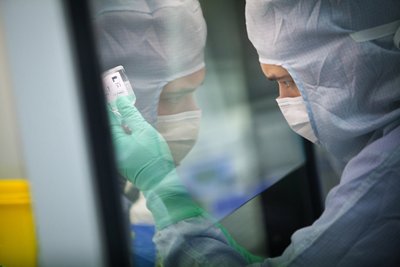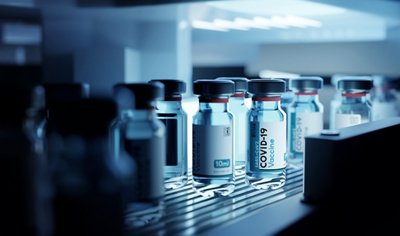Unlocking the potential of pharmaceutical production whilst elevating patient safety
By the bioMérieux Editors | Reading time: 5 min
PUBLICATION DATE: OCTOBER 11, 2023
Scientific discoveries, however important, are not enough to improve public health. Manufacturing infrastructure and innovation are needed to allow pharmaceutical companies to successfully and safely produce products at scale and make them available to clinicians and their patients.
Operating within the pharmaceutical industry can be incredibly complex, requiring specialised skills and expertise to navigate its many stringent regulations and codes of practice – a tenet that especially applies to the area of manufacturing and production. Contamination of a medicinal product or errors in packaging and labelling can put patients’ lives at risk, as well as creating major reputational damage to the pharmaceutical company responsible for the therapy. This means that careful consideration of how a drug will be manufactured must be factored in from the initial development stages and optimised wherever possible – ensuring quality and consistency.
Current challenges in pharmaceutical manufacturing
One key challenge facing pharmaceutical companies who want to remain at the cutting edge, is that the manufacture of breakthrough medicines typically involves high-cost, high investment processes. Take for example cell therapies, an advanced new type of biologic treatment which can be used to help replace or repair damaged tissue or cells or treat cancer patients with very good successful rate compared to standard of care. Such treatments are often developed in single batches and can only be produced using highly sophisticated and controlled processes. These added complexities in production not only require greater investment from manufacturers, but also make therapies themselves more costly for patients, thereby limiting access.
Pharmaceutical companies are also finding themselves under scrutiny when it comes to how they mitigate the environmental impacts of their business practices, including manufacturing. With climate change at the forefront of public consciousness it’s unsurprising that addressing the industry’s environmental sustainability is the primary concern of pharmaceutical employees1, however manufacturing is often considered the most difficult area in which to bring about environmental change2.
A further set of challenges await pharmaceutical companies looking to make changes to their manufacturing processes. As patient safety is paramount, any significant adaptations of manufacturing processes need to be approved by regulatory agencies. Compliance with these key regulatory processes in turn requires paperwork, time and investment – factors which can further deter pharmaceutical companies from making updates to any manufacturing approach. For those working across complex supply chains with multiple suppliers, the challenge to affect change within existing frameworks becomes even greater.
Overcoming barriers to innovation and change
Recent years have seen pharmaceutical companies embrace new developments in automation and digitalisation to help overcome current challenges affecting the industry, particularly in patient engagement. Innovations such as virtual healthcare services and monitoring have allowed companies to put patients in touch with the care they need from the comfort of their homes, freeing up overstretched in-person services. Additionally, new technologies such as wearables are generating a wealth of valuable data, that, with effective analysis, can deliver insights into the patient experience that previously went uncaptured.
By contrast, the uptake of new technologies within pharmaceutical manufacturing has been much less visible. A key limiting factor historically has been the existence of current regulatory frameworks – whilst such guidelines are clearly necessary to safeguard the quality of the final medicinal product, their complexity and rigidity has also meant that the pharmaceutical industry has not been at the forefront of innovating and adopting new technologies for manufacturing.

Additionally, the conversation about how best to integrate new technologies in manufacturing has often centred around concerns that machines will replace skilled workers – but a more fruitful discussion could be had by focusing on how workers and machines can deliver better results together, in collaboration3. By considering how the relationship between technology and human workers can be mutually beneficial, it becomes possible to increase the productivity of existing manufacturing processes and systems to be greater than is delivered by either human or machine productivity alone3.
The role of new technologies to improve efficiencies
One such example of an existing process that could be made more efficient is how drug manufacturers address microbiological control – a crucial step towards ensuring drug safety, that has traditionally relied on multiple, manual, low-skilled operations which are repetitive, time-consuming, and open to human error.
Currently, drug manufacturers use environmental monitoring to ensure that their clean rooms comply with industry standards, which involves gathering samples from different working areas in Petri dishes. All testing Petri dishes must then be incubated and visually examined at the end of several days of incubation (5 to 7 days) to check for contamination — a time consuming process that places pressure on workers to not miss anything, despite the fact that 90% of samples taken will deliver a negative result.
It stands to reason that an automated approach to conducting low skill checks like this would allow for a more streamlined approach to environmental monitoring. Harnessing new technologies to help record these data could also free up more time for skilled workers, enabling them to focus on other tasks that are vital to their work.
Another added benefit of integrating more automation and digitalisation across manufacturing processes is that when equipment operates at optimum efficiency and human error is removed as much as possible, less product is lost in the process, which in turn helps to limit waste. By taking advantage of new technologies such as trending analysis, predictive maintenance, predictive analytics and machine learning, companies can also detect inefficiencies in manufacturing processes and address them earlier.
Conclusion
Clearly, there are many challenges facing the pharmaceutical manufacturing sector, yet there is also considerable scope to both expand its outputs and drive the uptake of more streamlined practices.
The global response to the COVID-19 pandemic showed that when called upon the industry is able to step up to the challenge of upscaling pharmaceutical manufacturing and production, pivoting to meet the needs of patients. Whilst a shift in the current culture cannot be generated overnight, greater application of innovation is going to be necessary in order for the pharmaceutical manufacturing industry to remain in step with the demands of a constantly changing world and growing population4.
The global pharmaceutical manufacturing market was estimated to be worth over $500bn in 2022, a figure that is expected to grow at an annual rate of 7.63% until 2030. This market growth is only going to be possible however, if the industry is able to keep pace with developments in drug discovery and patient demand – an objective that can be achieved most effectively through the uptake of advancements in technology, more cost-effective processes and greater investment5.
1. Pharmaceutical Technology. Environmental sustainability in the pharmaceutical industry needs to be addressed the most: poll. February 2021. Available at: https://www.pharmaceutical-technology.com/news/environmental-sustainability-in-the-pharmaceutical-industry-needs-to-be-addressed-the-most-poll/?cf-view Last accessed October 2023.
2. Deloitte overview report 2022. Embedding environmental sustainability into pharma’s DNA. Available at: https://www2.deloitte.com/content/dam/Deloitte/uk/Documents/life-sciences-health-care/deloitte-uk-embedding-environmental-sustainability-into-pharma-dna.pdf Last accessed October 2023
3. L Belkhir, A Elmeligi. Carbon footprint of the global pharmaceutical industry and relative impact of its major players. Journal of Cleaner Production: Volume 214; 2019; 185-194
4. G Hole et al., Digitalization in pharmaceutical industry: What to focus on under the digital implementation process? International Journal of Pharmaceutics: X 3 (2021) 100095.
5. Grand View Research. Pharmaceutical Manufacturing Market Size, Share & Trends Analysis Report By Route of Administration, By Molecule Type, By Drug Development Type, By Sales Channel, By Age Group, By Formulation, By Region, And Segment Forecasts, 2023 – 2030. Available at: https://www.grandviewresearch.com/industry-analysis/pharmaceutical-manufacturing-market Last accessed October 2023.
You may be interested in these articles
SHARE THIS ARTICLE:
- Pharmaceutical Quality Control


